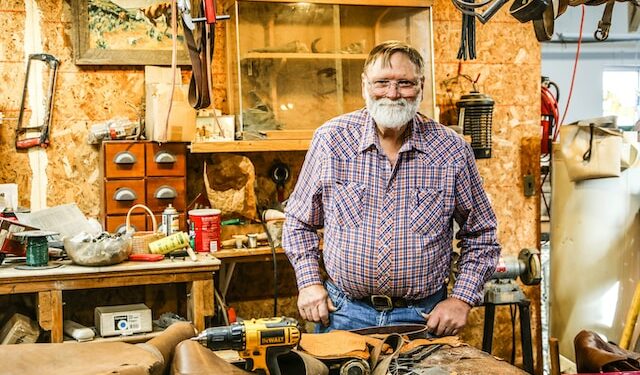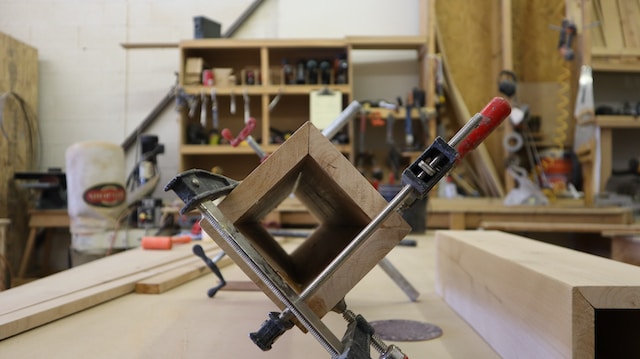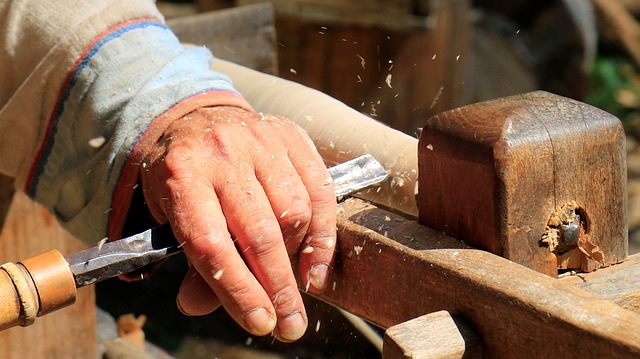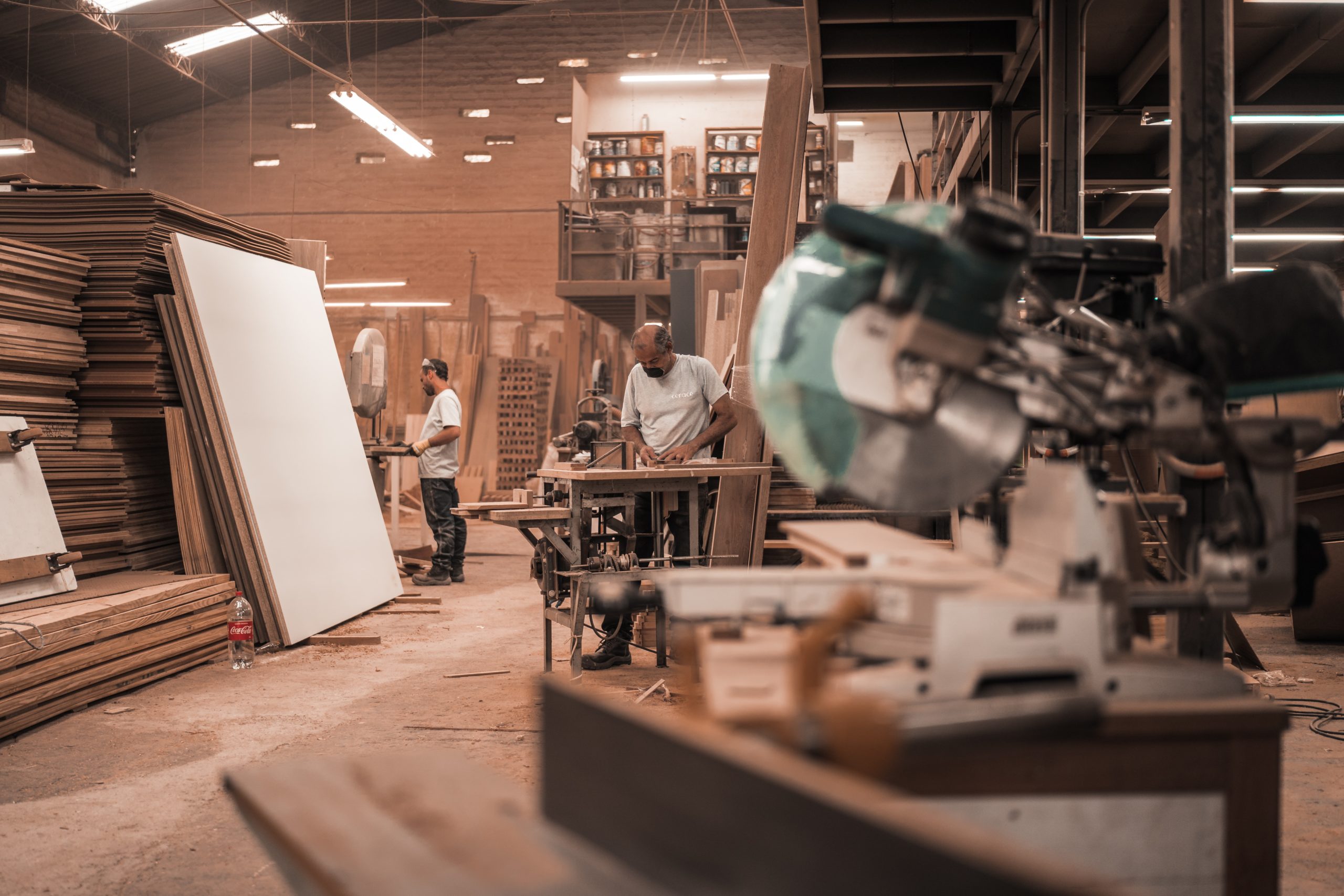The Top 5 Woodworking Instagram Accounts For Woodworking In Small Spaces

Living in a small space doesn’t mean you have to sacrifice your love for woodworking. With the right tools, techniques, and inspiration, you can create beautiful and functional pieces that fit perfectly into your compact living quarters.
And where better to find that inspiration than on Instagram? We’ve scoured the ‘gram to bring you the top 5 woodworking Instagram accounts for woodworking in small spaces. These accounts are full of tips and tricks for making the most of your limited workspace, as well as stunning projects that show just how much can be accomplished in a small space.
So whether you’re living in a tiny apartment or just looking to maximize your garage or workshop, these accounts are sure to inspire you to get creative with your woodworking. Let’s dive in and see what these woodworkers are up to in their small but mighty spaces!
Must-Follow Woodworking Instagram Accounts
Welcome woodworkers of the world, recently you may have noticed a lot more people have been engaging in woodworking projects and the internet has a lot to do with it. There are now Instagram accounts that are solely dedicated to woodworking! If you’re looking for some inspiring Instagram accounts to follow, you’ve come to the right place. I’m about to show you the top five must-follow Instagram accounts for woodworking in small spaces.
First up we have @woodworking_furniture. This is an account with over 15k followers, which means you are in for some pretty amazing content. They post a variety of projects from simple to extremely intricate ones. They also have videos that demonstrate different techniques for those who want to learn more about woodworking.
Second is @DIYWoodworkingProjects. This account is run by a passionate woodworker and their content is sure to inspire your creativity. They post tutorials and tips for starting projects and how to add beautiful details to your pieces.
Third is @SmallWoodworking, which might be just what you need if you’re just starting out with woodworking in small spaces. This is a great account for beginner woodworkers because they post easy to understand videos and pictures that demonstrate different approaches and techniques to working with small pieces of wood in a creative way.
Fourth is the account @woodworkingjunkie, which has helpful and inspiring content for small woodworking spaces. They have instructional videos and helpful tips for making projects a success.
Last is @woodworkingcourses, an account that is focused on helping new woodworkers to become experienced carpenters. They offer a range of courses that teach everything from how to choose tools to making intricate projects. As a bonus, they also have videos of traditional techniques for those who want to learn the traditional way.
So there you have it, the top five must-follow Instagram accounts for woodworking in small spaces. Now that your knowledge base has expanded you can get to work on your next woodworking project with confidence. Remember, the key is to practice and stay safe!
@Woodworking_furniture
Hi there! I’m here to tell you about one of the top five must-follow Woodworking Instagram Accounts for Woodworking in Small Spaces: @Woodworking_furniture.
If you love seeing beautiful, handmade furniture, this is the spot for you. @Woodworking_furniture offers a variety of stunning pieces crafted with passion by talented woodworkers from around the world. From modern designs to rustic farmhouse pieces, you can certainly find something to swoon over. I’m sure your friends and family will love it, too.
The furniture shared on this page is definitely dreamy and inspiring, but what I find even more remarkable is the amount of talent these makers have. It’s evident that a lot of time and thought has been put into these pieces, and each and every one seems to be crafted with love.
If you’re looking for some amazing, one-of-a-kind pieces to make your home stand out, @Woodworking_furniture should definitely be one of the first places you check out. They share a variety of handmade furniture and woodworking tips, so this page can be extremely beneficial for anyone looking to get started in the craft.
For those of you that are starting out in small spaces, this account offers some great ideas for utilizing your limited space. Their posts show designs that are customized specifically for small areas, and some of them even include images of how to make the most of the space.
So, if you’re into woodworking and want to find some inspiration for your next piece, or if you’re just looking for something special to spruce up your home, you should definitely check out @Woodworking_furniture on Instagram. The eye-catching designs paired with the talented makers make this account one of the top five must-follow Woodworking Instagram Accounts for Woodworking in Small spaces. Until next time!
@DIYWoodworkingProjects

Hey there all you aspiring woodworking fanatics out there! If you’re looking for some amazing ideas and inspiration for DIY woodworking projects, then @DIYWoodworkingProjects is the Instagram account for you.
This account is full of innovative ideas and awesome projects that you can take on yourself. Whether you’re just starting out with woodworking or a seasoned pro, there’s plenty to learn here. Check out their tutorials for everything from building a shed to crafting a cutting board.
The people behind this account keep things interesting with different projects each week. One week, they’ll be sharing details on how to make a custom bookshelf and the next they’ll have a guide on building a tiny home. They know how to keep you entertained and their content is always inspiring.
If you’re looking to learn some new skills, @ DIYWoodworkingProjects is the place to be. Thanks to their detailed instructions and illustrations, you’ll be able to build even the most complicated-looking projects. Make sure you take a few breaks while you’re tackling these projects since woodworking can be quite a challenge.
If you’re looking for some woodworking project ideas that will look great but are also suitable for beginners, the @DIYWoodworkingProjects team always has your back. A good starting project is a serving tray. This project doesn’t require too many tools and the end result looks great. It’s also a good way to practice basic woodworking skills like sanding and cutting.
With @DIYWoodworkingProjects, you’ll never be bored again. If you’re unsure of how to use a certain type of tool, @DIYWoodworkingProjects will show you the ropes.
Follow @DIYWoodworkingProjects today and take your woodworking game to the next level! With their help, you’ll be crafting beautiful projects in no time. Happy woodworking!
@SmallWoodworking
If you’re a woodworking enthusiast who’s just getting started and you’re working in small spaces, then @SmallWoodworking is an Instagram account that you should absolutely be following! Created and run by woodworking artist and enthusiast Angelica Spencer, this account is full of great advice and amazing projects that you can use to get the most out of your small space.
We all know that working in tight spaces can be quite a challenge, so Angelica’s tutorials and tips are a great way to add a bit of extra knowledge and skill to your woodworking skillset. In addition to that, she also offers a ton of advice on how to make the most of your small space, from storing your tools and supplies to making sure you’re working safely and efficiently.
When it comes to her projects, you’re sure to find something that will grab you. From creating storage crates out of small wooden planks, to building a gorgeous wall shelf out of reclaimed timber, there’s something for everyone. Each project is designed to be within reach of the average beginner, so you won’t have to worry about running into complex skills that need years of practice.
For those of you who are interested in learning a bit more, you can always catch one of Angelica’s online woodworking courses. Her courses are great for both beginner and intermediate woodworkers, and she offers tips, tricks, and helpful advice on technique and safety.
In the end, if you’re looking to take woodworking seriously and you don’t have a ton of space to work with, then you’re really going to benefit from an account like this. We all know that creating something out of nothing can be quite a challenge, so if you’re ready to get creative, then go check out @SmallWoodworking – you won’t be disappointed!
@woodworkingjunkie
For all of your woodworking needs, you can’t go wrong with @woodworkingjunkie. When it comes to tackling the challenge of woodworking in small spaces, this account offers a ton of fabulous tips and tricks.
When considering @woodworkingjunkie for your woodworking inspiration, you’ll be in for a treat! From easy-to-follow tutorials to creative projects, this account has been providing woodworking success for small space enthusiasts for years.
When on this account, you’ll also be able to find helpful advice on how to save space and make the most out of the limited space you have. From the way you store your tools to the type of wood you use for your current project, there are a ton of options available within the woodworking community.
The woodworking content on @woodworkingjunkie is also very inspiring. From small scale projects to larger builds, this account offers top-notch tutorials, inspirational pictures, and most importantly – fun!
And if you’re feeling really adventurous, you can also check out the DIY projects. This account has numerous projects that you can do on a budget, using unique materials and tools to make impressive things.
From beginners to seasoned pros, @woodworkingjunkie offers something for everyone who loves woodworking in small spaces. Whether it’s the resources, the tips and tricks, or the inspiring quotes, this Instagram account has it all. So, check it out and get ready for some fun woodworking in small spaces.
@woodworkingcourses

Welcome to the fifth and final account on our list of must-follow woodworking Instagram accounts: @woodworkingcourses! If you don’t know anything about woodworking and need help getting started, this is the account for you. From basic beginner projects to more advanced projects that’ll push your skills, this account is the perfect place to start.
Looking to learn more about the craft of woodworking? Start off with the easy projects like a wine rack or a kitchen chair. If you’re feeling a bit more ambitious, tackle a more complicated project such as building a frame for your TV. Meanwhile, woodworking courses will also show you how to choose the right wood for the job, teach you how to use the right tools, and even show you some tips and tricks on how to nestle your project in a small space.
Speaking of small spaces, @woodworkingcourses is especially adept at teaching you how to work with limited space. Maybe you don’t have the luxury of a garage workshop. No problem. Even if you’re short on room, this account can help you come up with creative solutions to fit your project in whatever space you have.
For more experienced woodworkers, this account can also help jump start new projects and teach more intricate techniques. If you’re having trouble find an appropriate joinery or need help deciphering a wood grain pattern, @woodworkingcourses can help you figure out the best strategy to reach your goal.
In addition to helpful guidance, this account also contains plenty of useful advice about woodworking as a whole. Whether you are just getting into woodworking or are a seasoned pro, this account can give you the tips and tricks you need to level up your woodworking game.
All in all, @woodworkingcourses is a must-follow account if you’re looking for woodworking tips and tutorials that are relevant for small space woodworking. And, if you happen to be lucky enough to have a dedicated workshop, this account still serves some great advice on how to make the most of your limited space. So, don’t stay away, log into Instagram and start following @woodworkingcourses today, and get ready to transform your projects into masterpieces.
Tips and Tricks for Woodworking in Small Spaces
Hey, everyone if you’re desperately trying to make your small living or work space work for you, then I`m here to help. You probably heard it before, it’s all about working smarter, not harder. Well in the case of woodworking in those small, cramped spaces, here are some handy tips and tricks to take your woodworking to the next level.
First, you gotta choose your tools carefully. The key is efficiency and mobility. So, you know, like, instead of bringing in the big plans and table saw to tackle a project, bring your jig saw and sandpalmwhich would to the job just as well, not to mention more manageable.
Next, get creative with your layout. You know how I usually like to max out space, like how I got ten guys into the house for a game of poker the other night. Like I said, you`ve gotta think outside of the box. Place your work bench in the center of the room, instead of pushing it up against a wall if it gets in the way.
Oh, and don`t forget about the lighting! Sure you can turn on lamps or flood lights, but does that really produce a quality job? It`s important to make sure you can see what you`re doing at all times. Get the best light around with good modern lamps and spotlights to really have control over the furniture that`s being worked on.
Another tip I would offer is to use removable workbenches. These are benches that can be easily slid in and out of your workspace, allowing you to open up the floor when you don`t need it on the job. And this leads me to my next point – safety first!
Working with power tools is not something to take lightly. If you don’t feel safe, don’t do it! Make sure everything is tucked away and you know exactly where it is at the end of each day. No one wants an injury when woodworking – or a house of cards fall when too many people are sitting at the poker table (that lesson was painful!).
And there you have it, my top tips and tricks for woodworking in small spaces. Remember, it’s all about keeping it efficient and practical. Woodworking in small spaces isn’t impossible, it just takes a little creativity and effort. Now get out there and get working!
Choose Your Tools Carefully
Ah the age old adage, “Choose Your Tools Carefully”! When it comes to woodworking in small spaces, even the most experienced of handymen have had to accept this as an important rule to live by, non-negotiable to the point that it might as well be scribed in stone.
That’s so you don’t find yourself with a table saw that literally takes up the entire room cause dang did you forget you were woodworking in a small space? So if you’ve got a tight squeeze, make sure that any tool on your wish list is worth its weight and size, literally!
In a small space, ‘size matters’ and I’m not talking only about your tools; you’re gonna have to pay close attention to the measurements of your surroundings. You can get yourself in some deep doodoo if you don’t plan ahead and consider the size of your space when selecting your tools.
The obvious tool means the no-brainers. It’s essential to have a variety of different measurement devices, hammers, saws, and drills. You’ll also want to get yourself a jig saw, screwdriver, and chisel. If that sounds like a lot, it’s because it is. But you don’t have to get everything all at once; you can start off slow and build up your collection as your work progresses.
However, you might want to consider buying some of the less effective tools, like an electric staple gun, a miter saw, a palm sander, and a biscuit joiner. These are tools that are especially useful for woodworking in compact spaces and are worth investing in for any serious woodworker.
And finally, don’t forget to consider safety when selecting your tools! This is especially true for beginners as things can get out of hand fast. Make sure to get quality protective gear such as tough gloves and eye protection when purchasing any power tools to ensure a safe working environment.
So there you have it folks, just remember to “Choose Your Tools Carefully” when woodworking in small spaces – your safety, and mine depends on it!
Get Creative with Your Layout
Are you a woodworker who is trying to make it in a small space? If you’re like me, you probably feel like you don’t have enough room to really make it work. But let me tell you, you don’t have to be confined by your space. All you have to do is get creative.
First, let me start with a little observation – square rooms are boring anyway. So why limit yourself? Learn to make the most of your space by embracing curves, diagonal lines, and other cool geometrical designs. Trust me, the only thing that is stopping you is your own creativity.
Second, think about rearranging the furniture in your shop around. This is especially important if you are working in someone else’s shop. You never know what sort of magic can happen when you start shifting things around. You might find that you have way more space than you thought you did!
Third, don’t overlook the importance of storage solutions. Take the time to find storage solutions, like overhead jars, pegboards and wall-mounted shelving. These can free up floor space and make it much easier to move around and work in your shop.
Fourth, use strategic plants in your shop to add a really nice vibrancy to an otherwise small space. Not only will plants help de-clutter your workshop, but they will also act as a natural air freshener. Just be sure to water them regularly and be aware of potential allergies.
Finally, don’t forget about the things that make you feel happy and inspired. Hang up your favorite artwork, photos, or quotes. Having these things around will make your shop feel cozy and add a splash of color.
So there you have it – these are just a few of the things that you can do to make the most of a small woodworking space. Get creative! Hang up some artwork, rearrange your furniture, and add some plants. You’ll be surprised how creative you can get with a little bit of imagination and effort. Who needs big spaces when you can create something beautiful in a small one? Happy woodworking!
Lighting is Crucial
Hey, everybody! Now that you’ve seen the top 5 woodworking Instagram accounts, we need to talk about an important aspect of woodworking in small spaces: lighting! Now, lighting is crucial! It might seem silly, but it’s all too easy to miss something crucial that could ruin your project because you don’t have enough of the right lighting in your workspace. First things first – make sure you have enough lighting for the space. Natural light can be wonderful, but it won’t necessarily give you the illumination you need every time.
So, make sure you have enough lightbulbs in the room for your woodworking needs. Secondly, you want to make sure you have a good mix of warm and cool light. This will help you better discern between different types of wood and color accents. Finally, you want to make sure you don’t have shadows that can interfere with what you are doing. Place your lights in different directions to prevent shadows on your workspace while you’re working.
Most of all, don’t forget that lighting can be a great way to create a soothing, pleasant work atmosphere. Don’t forget to configure your lighting and workspace so that you can work in peace and comfort – and get the job done right!
Follow these tips and you’d be surprised at how much quality woodworking you can do in a small space. Now go ahead, get out there and become a master of lighting! Thank you, and good luck!”
Use Removable Work Benches
Hey my fellow woodworking enthusiasts, have you been struggling to find projects to complete a woodworking project in a small space? Not to worry! I’m here to tell you that you don’t have to compromise on your woodworking dreams. You just need to adjust some of your approach and use some smart solutions.
One creative and clever way to work with a small space is to use removable work benches. You can customize your work bench to fit your space and make sure you don’t take up much room. By using a removable work bench you can easily adjust the size and height of the bench, so you get the best working experience possible.
When you use a removable work bench for your woodworking projects, you’ll find the process to be much simpler. You don’t have to worry about measuring out the space and making sure your design fits properly – instead you can build within the limits of the bench. Plus, the bench itself is easy to put together and disassemble. That means you can keep it away when you’re done, or use it multiple times without taking up that valuable workspace!
When you’re woodworking in a small space, having a removable workbench can be a major advantage. Since the workbench can be easily moved it helps create a sense of flexibility in a tiny space. You can move the bench around to create different working areas so that you can have the best working experience possible.
Plus, when you have the option for a removable workbench, you know that you can find uses for it later. For example if you use the removable workbench for a small project, you can also use it as a table or a surface for building something else entirely. This flexibility of use makes the bench an ideal choice for when you’re working in a small space.
So the next time you’re looking for a solution to your woodworking projects in a small space, consider a removable workbench. Not only can it provide extra support for your projects and make them easier to complete, but it can also give you a great deal of flexibility. You’ll be able to move the bench around as needed, giving you that extra space when you need it most.
And of course, let’s not forget the best part: by using a removable workbench, there’s no need to keep packing and unpacking tools and supplies. You can keep your tools, supplies and projects in the same place easily and have the opportunity to get creative in a more organized space.
Remember, with a removable workbench you can make woodworking in a small space possible and enjoyable. Don’t let small spaces limit your woodworking pursuits, get creative and use a removable workbench, you won’t regret it!
Safety First

Ah, safety first! You ever hear my good friend say that? Well it’s definitely true when it comes to woodworking, even when it’s in small spaces. Pay close attention to this one everyone as it’s a very important part of your woodworking journey.
Now, some of you may think that because you’re working in a small area, it’s safer than, say, working in a full garage. That ain’t necessarily the case! You have to be extra vigilant when woodworking in a confined space because you don’t have the luxury of moving around as freely as you would out in the open.
Now, one of the most important things to always remember is to wear the proper safety equipment such as a dust mask, protective eyewear, and gloves. And if you’re using any type of power tools be sure to use safety goggles and earplugs. I’m sure you don’t want to look back on your woodworking days and see yourself looking like a hockey player with all those deep scratches and bruises!
Also, use clamps whenever possible. Clamps help to hold pieces in place while you’re sawing or drilling into them – they’re like little extra hands that you don’t want to be without. Plus, they help to keep your work area an organized mess! You don’t want to trip over your wooden pieces accidentally cause that would hurt, trust me.
And finally, make sure to unplug all power tools when they’re not being used. Of course, it’s always smart to double-check the power source to make sure the tool is turned off when you’re done.
So, there you have it. Safety first people! Now, go forth and make some awesome woodworking pieces in your small spaces. And remember, keep it fun – let the laughter and the wood shavings fly!
Awesome Content for Woodworking Beginners
If you’re new to woodworking, getting started can seem like a daunting task. But thanks to the great content available on the top 5 Instagram accounts for woodworking in small spaces, you’re sure to get the best advice and guidance. Here’s what you should check out:
For starters, check out @DIYWoodworkingProjects, which offers awesome DIY projects that fit even into the smallest of spaces. Whether you have a tight budget or just want to have fun, they’ll guide you through the entire process, making sure you realize your custom dreams without breaking the bank. And if that’s a little overwhelming, never fear; there are lots of handy step-by-step tutorials to show you just how simple it really is.
Next, look no further than @SmallWoodworking, who share some of the most inspiring content on the ‘gram. Take a look at the pictures of their finished projects and you’ll be amazed at how beautiful even the simplest of pieces can become. They also provide helpful video tutorials and advice for beginners, as well as more advanced designs for experienced woodworkers. It’s an inspiring community that’s sure to get you motivated to start your own.
Speaking of community, the woodworking community is vibrant and supportive. @woodworkingcourses is the perfect place to start if you’re new to the process, offering excellent woodworking courses and lessons to teach you the essentials. You can even find great deals on woodworking tools, which is always a plus.
And if you’re stuck at home, unable to buy that perfect piece of wood, you can get creative with what’s available. With @woodworkingjunkie, you can follow the adventures of their experiments and learn how to recycle and repurpose objects of all shapes and sizes. Even if you’ve never heard of upcycling, you’ll get plenty of ideas from their posts.
Finally, just popping in to the @woodworking_furniture profile will give you a great sense of what’s possible. Everything from tables to chairs, sofas and even beds are all made from wood, and should inspire you to take on your own projects. They provide plenty of clues and inspiration to get your projects off the ground.
With tons of awesome content to explore, the top 5 woodworking Instagram accounts are sure to have something that will fire up your woodworking passion. From DIY tips and tricks, to buying the right wood, to staying safe while working, you’ll find everything you need to know. So what are you waiting for? Get in there and get creative!
DIY Projects on a Budget
The first thing that yo must know about DIY projects on a budget is: Whoa! They really can be super cool! Yes, you don’t need to worry about spending a lot of money for your little projects and you can even use recycled materials for them.
When selecting materials for your projects, always go for the ones that complement the other elements of your home studio. For example, if you love wooden furniture, then be sure to use the same kind of wood for your small space DIY projects. This will make it look more put together and more cohesive overall.
Furthermore, you’re gonna need a few tools to cut and shape the wood to your liking. You can also find tools at your local hardware stores. Make sure, however, that you get the right type and size for the task you have in mind. You don’t want to buy a tool that’s too big and it won’t fit in your limited working area.
Another consideration you should think of is the budget. Choose materials and tools that you can afford and that won’t break the bank. If you’re on a tighter budget, you can always DIY your own tools or modify already existing ones. It’s up to you to get creative and use whatever resources you have at your disposal.
When it comes to DIY projects you should also remember to be mindful of your safety. Avoid using electrical tools if you don’t know what you’re doing and make sure that you wear the proper safety gear like goggles, gloves and dust masks. Safety should always come first!
So there you have it, folks. With a bit of effort and the help of these handy tips, you can set up your DIY projects easily and without spending a fortune. Now get out your tools and get to it! I’m sure you’ll find the result satisfying and you’ll have created something of your own making. That’s a good feeling right there.
Step-by-Step Tutorials
Here to bring you the best of the best when it comes to step-by-step woodworking tutorials! If you’re tight on space, but still want to create beautiful woodwork projects, then look no further! These step-by-step tutorials make it easy for you to learn the skills you need to become a successful woodworker, even in tight quarters!
Let’s start with a classic project – making a wooden table. First things first, you need to measure your space so that you can make sure your wooden table will fit. You’ll also need to find the right type of wood. A sturdy hardwood is always a good choice. Once you’ve got the measurements down and the wood chosen, it’s time to start cutting! You’ll need an accurate saw and a well-made workbench so that you can be sure your cuts are precise.
Next comes the time consuming but important part – sanding! The key to beautiful woodworking projects is to make sure that all the parts fit perfectly together – which means sanding them down until the edges and surfaces are perfectly smooth. For this project, you’ll need a few different grades of sandpaper and the patience to take your time sanding your table so that it looks perfect.
Once your table is sanded, it’s time to start putting it together. You’ll need to carefully measure the wood so that all the pieces fit together. To do this, you’ll need to use a variety of tools such as drills, saws and routers. Once everything is lined up perfectly, you can start assembling your table. A good wood glue is a must-have for any woodworking project, so be sure to get a quality glue before you assemble your table.
After you’ve put the table together, you’ll want to make sure that it is protected from the elements. A good coat of sealant or varnish will protect your table from wear and tear over the years. Once it’s sealed, you’re ready to enjoy your brand new, space-saver wooden table!
So there you have it – the basics of woodworking in a tiny space! Now that you know the basics, why not find some great woodworking Instagram accounts and get inspired to start creating your own beautiful works of art! Good luck and happy woodworking!
Join a Woodworking Community
If you’re new to woodworking, then one of the most important parts of getting started is to join a woodworking community! A woodworking community can provide invaluable support and advice, as well as tips and tricks to help build your knowledge and skills over time.
For starters, you can look for woodworking meetups and clubs in your area. These are great places to network and find woodworkers who are willing to help out or offer advice. Plus, it’s a great way to get your name and brand out there as a woodworker.
Another great source for learning more about woodworking is an online community. These can range from forums dedicated to a particular type of woodworking, such as furniture-making, to general woodworking networks like Reddit. There are also tons of woodworking blogs and Instagram accounts, which can be good for gathering more information about woodworking and getting inspiration for projects.
Also, look for woodworking shows and expos. These are often held in different cities and can be great opportunities to learn from the best woodworkers in the world. You may even be able to take home a souvenir, like a signed woodworking tool!
Finally, don’t forget to join woodworking competitions. Here you’ll be able to showcase your skills, get critiqued by expert woodworkers, and maybe even win amazing prizes! Who knows, you might even give E.T. a run for his money!
All in all, no matter where you are on your woodworking journey, joining a woodworking community can be an invaluable asset. You’ll be able to find people who share the same passion and skills, who can help you stay motivated and challenged. So, don’t be afraid to try it out – you never know what you might learn!
Buy the Right Wood

Hey! Buying the right wood can be daunting but also really satisfying. Here at Woodworking Store, we’re here to help you become woodworking aficionados when it comes to selecting the right kind of wood!
Let’s start with the basics. Do you want pine, oak, or cherry? When you select the right kind of wood, the whole project will look better and stay together longer, too. It’s important to remember that the kind of wood you use will depend on where you want to place the project, since some woods may not work in certain environments. For instance, pine is cheaper but doesn’t last as long in humid environments as oak or cherry.
Another tip: if you’re a beginner with limited skill, it’s probably better to stick to softwood, which is easier to shape and usually more affordable than hard wood. And remember: the price you pay for wood is often based on the grade—so make sure you understand those points.
You also want to make sure you end up with the right size piece of wood for the project. You can buy wood pre-cut to certain sizes, but it can be more satisfying to measure and cut your own. If you want to save money and get really creative, it can be fun to scrounge for another wood pieces at lumberyards or DIY stores!
Finally, when it comes to woodworking, you get what you pay for. The cheapest option isn’t always the best, so make sure you look around and compare options before settling on one. That way, you’ll be sure to get something that’s right for you and your project.
Happy woodworking, y’all! Now get out there and create something truly unique!
Do It Yourself Woodworking Advice
Hey hey! Are you a fan of woodworking, but especially in small spaces? Oh boy, do I feel you. It’s hard to find enough room to get all of your tools and supplies in order to make awesome things – trust me, I know. But don’t worry, there’s a way to make it happen. Let me give you a little bit of do-it-yourself woodworking advice that’ll help you conquer small spaces.
First off, measure twice, cut once. This old saying applies to woodworking just like it does to anything else – except maybe measuring the sugar when you’re baking a cake. No one wants to waste any of that precious wood, so make sure you make a mark exactly where you want to cut and double check it before picking up a saw.
Ed, the woodworker’s best friend, is wood glue. Not just any wood glue, though – pick the right kind for the job depending on the two surfaces you’re connecting. If you’re unsure, ask for advice at a local hardware store. It may help you out in the long run.
If you’re getting serious about woodworking, you’re going to need to learn some different joint types. I might be biased, but miter joints are my favorite – they look great when they’re done properly and can add a special touch to any project. But there’s a lot of others to choose from, so do some research and find the joint that’s right for you.
Safety first! You’ve heard it a million times, but it’s worth repeating – wear the right gear when you’re working on any project. Eye protection is a must, no matter where you’re doing your woodworking, and don’t forget a good pair of gloves. Accidents happen, and it’s better to be safe than sorry.
Last but not least, my final bit of advice is this – use sandpaper sparingly. Sandpaper is a woodworker’s best friend … but it’s easy to get carried away and sand away too much of the material. It takes influence and finesse, so go easy or you may regret it later.
There you have it – my top five do-it-yourself woodworking advice tips! Keep these tips in mind as you tackle your small space projects and you’ll be a pro before you know it. Happy woodworking!
Measure Twice and Cut Once
Are you ready to take the plunge and complete your next woodworking project? One of the most important rules of woodworking you can’t ignore is to Measure Twice and Cut Once. You see, wood is expensive and if you mess up your piece after you’ve cut it, you can’t really get it back and you’ll end up wastingwood and money.
Now I know this sounds like common sense, but if you are working in a small space or with very limited resources, it’s easy to make a mistake. If you don’t measure twice, it’ll cost you. So here’s my advice – don’t cut your pieces until you are absolutely positive about their dimensions and the measurements are spot on.
And if you want to take it a step further, measure the dimensions of your space as well. This will help you figure out how much space you have to work with and to make sure that your pieces fit properly in your space.
Now, I know what you’re thinking. If you’ve already started your project, it’s too late to measure! That’s not true! It’s never too late to measure twice and cut once. Yes, there may be an extra step in the process, but it’ll save you time, energy, and money if you measure before you cut.
Anyway in conclusion, my advice is to take your time, measure twice, and cut once. That way you’ll be able to enjoy your woodworking project without having to worry about mistakes or wasted wood. Oh and don’t forget – safety first!
Pick the Right Wood Glue
Ha, wood glue! You gotta love it. Ahh the importance of picking the right one. Everyone says that their glue is the best for woodworking, but it can be tricky to figure out which one is actually best for your project.
If you’re joining two pieces of wood together for a project, you have to be sure to use the right type of glue. For example, if you’re using a soft wood like pine or cedar, you’ll want to use a yellow wood glue. This type of glue is designed to create a strong bond between the two pieces. On the other hand, if you’re joining hardwoods, you’ll want to use a white glue like Elmer’s. This type of glue isn’t as strong as yellow glue, but it will still provide a good bond.
It’s also important to make sure you have the right tools for the job. For example, you’ll need a cloth or sponge to apply the glue in order to get a better distribution. Likewise, you’ll need a brush to get into the nooks and crannies of the piece of wood. It’s also a good idea to have a damp rag handy in case you need to wipe away any excess glue.
Finally, it’s important to know how long the glue needs to set before use. Most wood glues need to be clamped for at least 20 minutes in order to get a strong bond. If you need to work on a project right away, you’ll want to opt for a quick-set glue. This type of glue will set much faster than traditional glues, but won’t be as strong.
In any case, you’ll want to make sure you pick the right wood glue for your specific project. A good wood glue will hold up to the wear and tear of your project and make it look great for years to come. Do your homework before you make any decisions and pick the right wood glue for your project!
Consider Different Joints

If you’re about to embark on a woodworking adventure, you’ll want to consider different joints. Joints are very important for a finished product that is both sturdy and looks great. I get a little tripped up in this area since it can get a bit tricky. But don’t worry, I’m here to help!
First of all, what’s a “joint”? A joint is simply a way to connect the different pieces of wood. There are lots of different types of woodworking joints, so you’ll have to decide which is the right one for your project. Obvious examples of joints include the butt joint, the lap joint, the miter joint, the dovetail joint, and the mortise and tenon joint. The choices might seem intimidating, but don’t worry – you’re gonna nail this! (pun intended!)
Let’s take a look at what some of these different joints mean. The butt joint is the most popular because it’s so easy to use. You basically just put the two pieces of wood together and use nails or screws to hold them in place. Now, this joint won’t provide a ton of strength, but it will do the job in most cases.
Maybe you want something a little stronger? Enter the lap joint. This is where you basically glue two pieces of wood together, using a dowel or spline to add a bit of extra strength. I know it sounds a little complicated, but trust me – this joint creates a surprisingly strong connection.
If you’re looking for something more decorative, the miter joint is a great choice. It’s essentially just a butt joint, except that instead of butting the pieces together you bring them to a 45-degree angle. Secure with some wood glue, and you’ve got yourself a stylish joint.
The dovetail joint is also a great option for all you woodworking superstars out there. This is a bit complicated and might require some practice. Basically, it involves cutting the ends of your wood into interlocking “dovetail” shapes. When you slide them together, they create an incredibly strong connection that’s great for furniture or cabinets.
Last but not least, we have the mortise and tenon joint. This one is commonly used for furniture. You take two pieces of wood, cut a hole into one of them (the mortise) and a corresponding tab into the other one (the tenon). When the two pieces are put together, the tenon fits into the mortise and creates a super-strong bond. You’re basically just locking these pieces of wood together like a puzzle piece.
Well now, I guess we’ve covered the basics. All this talk of joints has me feeling a bit peckish – maybe I’ll go grab a sandwich. Keep in mind that whichever joint you choose, practice makes perfect! So get out there and have some fun with it.
Always Wear Safety Gear
If you follow the woodworking Instagrams I mentioned above, you’ll know that no woodworking project is complete without safety gear. That’s right, you gotta make sure you wear your safety goggles, a dust mask, and a pair of heavy-duty gloves when you’re cutting, drilling, sawing, or shaping any kind of wood.
Hey, I know some of you folks are probably rolling your eyes right now, because let’s be real – safety gear doesn’t look good. It makes you look like an extra in a sci-fi movie, ya know what I’m saying? But look, I’m not asking you to dress to impress, I’m asking you to dress to stay safe.
Besides, what is it worth, ruining your eyesight? Or getting splinters or cuts all over your hands from working with unfinished wood? Or worse – getting something lodged in your throat from a sawdust cloud?
So when you’re enjoying your woodworking Instagrams, don’t forget to stock up on your safety gear. You need to make sure that whatever you’re sawing, drilling, and cutting has a pair of eyes, a mouth, and a pair of hands watching over it.
And trust me when I tell you that the safety gear isn’t just for the woodworking project, it’s for your safety.
At the end of the day, it’s important to remember that when it comes to woodworking in small spaces, safety is key. So always have the right safety gear with you and on you, even if it doesn’t make you look like a style model, at least you and your woodworking projects will stay safe.
Use Sandpaper Sparingly
Ah, sandpaper. The tool of the trade for any woodworker. Whether you’re prepping a surface for staining, planing a board for a better fit, or sanding down a finished piece for a smooth finish, without sandpaper, your project would look like a hot mess.
Now, I know some of y’all out there have dreams of turning your small workspace into a sandpaper paradise, but I’m here to tell ya, take it slow!
That’s right, when it comes to sandpaper, less is more. Too much sanding can lead to a rough finish that’ll be harder to finish with a lacquer or wax down the line. So, before you start sanding, take a step back and ask yourself if you really need to. A good rule of thumb is to keep the grit on the sandpaper low, especially in tight spaces.
Beyond that, make sure you save the heavy sandpaper for the really tough jobs. For the smooth finish that many woodworking projects require, you should stick to finer grit sandpapers like 400 or 600 to get the job done.
Lastly, remember that no matter how much sandpaper you use, you’re still going to have to clean up the dust. Especially in small spaces, dust can quickly accumulate in every nook and cranny, and it can be hard to get rid of. So even if you don’t feel like using a vacuum cleaner, make sure you use a damp cloth to wipe off any dust that’s settled onto the surfaces.
So, there you have it. Just remember, use sandpaper sparingly, and your small workspace will be turning out showroom-ready pieces in no time. Now, who wants a beer?
Final Thoughts
If you’re reading this, then you have discovered some of the top woodworking Instagram accounts for small spaces. Congratulations! Woodworking in small spaces can be a tricky business and it can often feel like an impossible feat. But, I’m here to tell you, it doesn’t have to be.
Firstly, embrace the challenge! Woodworking in small spaces can be a very satisfying experience once you figure out the lay of the land. Don’t be discouraged if it seems a bit overwhelming at first. It’s completely natural. Take your time and experiment with different techniques and tools. You might surprise yourself with what you can accomplish.
Secondly, never stop learning new techniques. Once you become comfortable with woodworking in small spaces, continue to expand your skill set. Read up on woodworking best practices and be sure to watch plenty of tutorials. There’s lots of great woodworking knowledge out there! Plus, with the help of the woodworking Instagram accounts we’ve just outlined, you’re sure to learn lots of useful tips from some of the most experienced woodworking experts.
But most of all, make sure you have fun! Woodworking can be a great creative outlet and a therapeutic escape from the stresses of everyday life. So make it a fun experience and don’t take it too seriously. I’m sure you’ll be surprised with what you can create.
Making something with your own two hands is a great sense of accomplishment. So don’t put too much pressure on yourself and have some fun with it. I hope you’ve been inspired to take on your own woodworking projects and created something amazing. Good luck!
Embrace the Challenges of Woodworking in Small Spaces
Hey everyone, it’s me, here to talk to you about the challenges of woodworking in small spaces. Now, I know what you’re thinking: “you’ve never done woodworking. What do you know?” But you’d be surprised how well I’ve picked up the basics of woodworking, so I’ll give you some tips.
It’s no secret that woodworking in small spaces presents its own set of challenges. Working in a confined space can be tricky, so the key is to make the best of it. You’ve got to learn to do more with less. That’s where the creativity comes into play. It pays to get creative and think outside the box with your woodworking projects. Focus on the possibilities that your small space offers and make the most of it.
When it comes to woodworking in small spaces, one of the most important things to keep in mind is to be organized. This means not just planning out your woodworking projects, but also keeping everything organized in the space. Make sure you have a designated spot for your tools and other items and make sure that everything is easily accessible. This will help you to maximize the efficiency of your workspace.
Another handy tip for woodworking in a small space is to add some additional storage. If you have some extra room, consider buying some shelves to help store your tools and materials. This can help you to keep things off the floor and out of the way.
Finally, don’t be afraid to use the wall space in your small space. Hang up some pegboards or clips to make arranging your tools easier. You could even mount a few shelves to the wall to make even more space.
So there you have it, a few tips for woodworking in small spaces. With the right attitude and a little bit of creativity, you can make the most of your small workspace. Be sure to check out the top woodworking Instagram accounts for more ideas and inspiration. Have fun and get creative!
Keep Learning New Techniques
Oh boy – when it comes to woodworking in small spaces, there’s no time to rest on your laurels. You have to keep learning new techniques if you want to stay ahead of the curve. Sure, it may seem daunting at first, but that’s just the beauty of it. All the creativity, problem-solving and trial-and-error involved in learning a new skill makes you an invaluable asset.
Are there any advantages to picking up these new skills? Absolutely! Not only is it great for your brain to start expanding in ways you never thought possible, but you get to make fantastic creations that are entirely your own. And let’s not forget the perfect satisfaction of making something with your own two hands. You just can’t beat that feeling.
So, how do you go about learning these woodworking techniques? Well, you could go the traditional route and learn from a book or tutorial. Although this is still a great way to go about it, technology has made it easier to learn the ropes. You can find awesome woodworking courses online that explain everything you need to know in a fraction of the time a book would take. Plus, you can search specifically for techniques related to small-space woodworking which gets you up to scratch a whole lot quicker.
You should also try finding local woodworking classes or workshops to support your growing skills. This adds an element of socialization to the experience which can be fun and motivating as well. Plus, it’ll help build confidence when with the help of others while getting more intricate with your projects. Plus, you may even be lucky enough to find a mentor who’s been crafting wood for years.
Finally, try joining online woodworking communities to learn more in-depth techniques. From blogs and forums to galleries filled with creative projects and even virtual competitions – there’s an incredible wealth of information and techniques for you to discover. You can also network with like-minded individuals who will motivate you stay on top of the latest trends and help you progress on projects.
So, there you have it! Pick up a few tips, take some courses and join a woodworking community – it’s that easy. Learning new woodworking techniques may seem intimidating at first but don’t let it get you down. With the right resources and dedication, you can master the skill of woodworking in small spaces in no time.
Make It Fun!
There’s no need to dread woodworking in small spaces, because if you make it fun,you’ll be able to tackle any project. This is the thought of the day if you’re woodworking in small spaces.
If you want to make sure that your woodworking projects are fun, the first and most important step is to start off with a plan. Make sure that the plan outlines the tools you’ll need, the steps you’ll take to complete the project, and how you’ll measure your success. Once you’ve got a plan, gather all the materials you’ll need in advance so that you don’t have to worry about hunting them down in the middle of a project.
Secondly, make sure you’re working in a comfortable environment. Put on some nice music or pull up a podcast, set the temperature to an ideal level, and grab some snacks to have on hand. It might also help to keep some water bottles in reach since woodworking can be labor-intensive and require a significant amount of energy.
Be sure to also familiarize yourself with all the tools you’ll use during your project. Go through all the instructions and make sure you understand how to use each one. You don’t want to run into any issues due to a lack of knowledge, so slow and steady is the key.
Finally, don’t forget to make it fun! Turn on your favorite music, snap a few pictures of your work as you make progress and most importantly, remember to have fun. With the right attitude, you’ll be able to create amazing pieces of art that you can be proud of.






